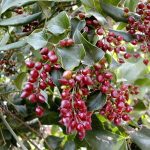 Sarsaparilla, a carbonated beverage and acclaimed medicinal tonic, takes its name from the plant from which it is made. In turn, the sarsaparilla plant likely derives its name from two Spanish words: zarza, meaning bramble, and parilia, which is the diminutive form of the Spanish parra, meaning vine. Further back, the Spanish word zarza derived from the Arabic word xarac, also meaning bramble or prickly plant. As a plant name, sarsaparilla first appeared in English in the late sixteenth century, but it was not until the 1840s, when it became the name of a soft drink, that the word achieved wide currency. The popular belief that sarsaparilla takes its name from a Dr. Parilla may have arisen on the analogy that Dr Pepper, the name of another American soft drink, actually does take its name from a Dr. Charles Pepper.
Sarsaparilla, a carbonated beverage and acclaimed medicinal tonic, takes its name from the plant from which it is made. In turn, the sarsaparilla plant likely derives its name from two Spanish words: zarza, meaning bramble, and parilia, which is the diminutive form of the Spanish parra, meaning vine. Further back, the Spanish word zarza derived from the Arabic word xarac, also meaning bramble or prickly plant. As a plant name, sarsaparilla first appeared in English in the late sixteenth century, but it was not until the 1840s, when it became the name of a soft drink, that the word achieved wide currency. The popular belief that sarsaparilla takes its name from a Dr. Parilla may have arisen on the analogy that Dr Pepper, the name of another American soft drink, actually does take its name from a Dr. Charles Pepper.
A tropical American greenbrier.
Woody perennial native to New England. Bark and roots have special action on the kidneys. Of merit for dropsy, gravel and other urinary diseases.
A tropical vine, the extract of which gave its name to a variety of nostrums that became popular in the mid-19th century. The Smilax vine is found throughout the American tropics and subtropics. The extract of Smilax known as sarsaparilla was originally introduced into Europe in the 16th century as a cure for syphilis, though it proved to be an ineffective treatment. When sarsaparilla reappeared in the 18th century, it was offered as a health tonic and purifying agent for the blood. Manufacturers imported Smilax plants from the tropics and used a domesticated form called Aralia nudicaulis.
Among the first to market sarsaparilla in the United States was C. C. Bristol. In the 1840s, Bristol’s sarsaparilla led the market over a number of similar products, each of which advertised itself as a more potent form of sarsaparilla. However, Bristol’s and its competitors were over¬ whelmed by James Cook Ayer’s product, Ayer’s Extract of Sarsaparilla. Ayer, a physician graduate of the University of Pennsylvania, was one of the first patent-medicine manufacturers who understood the importance of the U.S. West as a new market. After the Civil War he marketed a set of products including Ayer’s Extract of Sarsaparilla. As Ayer became more successful, he expanded his operation, even buying an interest in a railroad in order to move his product from Lowell, Massachusetts, his manufacturing center, as cheaply as possible. He died in 1878 a wealthy man and honored citizen of Lowell.
The topic at hand is a plant native to tropical America, whose roots are utilized in producing a previously trendy carbonated beverage bearing the same name. The essence of the flavoring is a dark brown hue and characterized by a sharp, acrid taste. It is still utilized in the production of carbonated drinks.
Discover a remarkable flavoring derived from the dried roots of the Smilax plant. This botanical extract, once employed to create a revitalizing chilled beverage, now finds its purpose in imparting its distinctive essence to carbonated drinks. Immerse your senses in the delightful flavors crafted from this unique plant, as it adds its touch of refreshment to a range of carbonated beverages.
